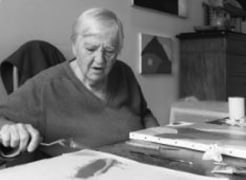
Opening Thursday, June 22, 2023, 6:00pm – 8:00pm
Galerie Lelong & Co., New York is pleased to announce (Un)belonging, a group exhibition presenting both historic and new works by Etel Adnan, Ficre Ghebreyesus, Jane Hammond, Alfredo Jaar, Rosemary Laing, Athena LaTocha, Ana Mendieta, Zilia Sánchez, Michelle Stuart, Barthélémy Toguo, and Krzysztof Wodiczko. The works in the exhibition site the establishment of identity through the precarity of place; investigating the politics of belonging to locales both physical and invisible.
Commanding the gallery space is Krzysztof Wodiczko’s Poliscar Variant 2 (1991/2017), a contemporary rendition of the artist’s 1991 generative work Poliscar, which underscores the exclusion of the homeless from their environment while providing a meaningful means of participation. The title of the work comes from the Greek word polis for city-state, which refers more to the social structure of a community and the participation of its citizens than to a specific institution or place. The Poliscar is a three-wheeled vehicle that looks like a tank, fitted with a motor to facilitate habitability and movability. While Poliscar makes the homeless visible in public space, Wodiczko’s interrogative design extends beyond marking the urban landscape to include various communication tools contained inside, intended to establish a network among homeless people.
In the smaller gallery, works by Cuban-born artists Ana Mendieta and Zilia Sánchez are exhibited in dialogue. Deeply affected by her exile from Cuba to the United States at just 12 years old, Mendieta created over 200 ephemeral “earth-body” works in various locations. A return to the landscape, the artist stated: “These obsessive acts of re-asserting my ties with the earth are really a manifestation of my thirst for being.” On view are four works she made in the embankments of Caumsett State Park, Long Island, New York in 1983. Zilia Sánchez, feeling alienated from the New York art world during the 1960s, settled in San Juan, Puerto Rico in 1971, where she continues to live and work. It was there that she forged her first public work. The drawings and intimately-scaled sculpture demonstrate the artist’s uniquely sensual and corporeal approach to abstraction while highlighting Sánchez’s evolving interest in completely free-standing work.
In their respective practices, Etel Adnan and Ficre Ghebreyesus—two artists who experienced displacement from their native countries—draw upon memories of the landscape to craft imagined spaces, conveying their emotional responses to these environs through expert handling of color. A pair of seascapes by Ghebreyesus are marked by solitary red buildings that emerge as beacons of refuge. Ghebreyesus, who left Eritrea as a teenage refugee during its War of
Independence and ultimately settled in New Haven, Connecticut, evokes both the loneliness of migration and the sustaining power of home in these dream-like compositions. Etel Adnan, who was born and raised in Lebanon, but lived, studied, and worked in France and California, often drew inspiration from the landscape, infusing it with the sentiment of displacement. Her tapestry Envol (2017) depicts dove-like forms in ceaseless flight set against a bold and colorful background marked by stripes of terra cotta, green, and blue reminiscent of land, sea, and sky.
Artists Rosemary Laing and Barthélémy Toguo critique the relationship between contemporary society and the environments it inhabits by subverting conventional natural imagery. For her photograph groundspeed (Rose Petal) #17 (2001), Laing laid an industrially produced, floral-print carpet across the forest floor. In Creole Love Song (2018), a watercolor by Toguo, two unnaturally large birds hold human heads in their talons.
The physicality of land becomes a key component of works by Michelle Stuart and Athena LaTocha. Project for a Chart of the Earth Reflecting the Sky (1983), a sculptural book work by Stuart composed of earth from Zagora, Morocco, handmade paper, and plaster, cannot be read page-by-page, but rather as a form—a tangible documentation of the site from which the earth that colors it was sourced. LaTocha, who incorporates soil and minerals sourced from specific sites into works that recall not only the personal experience of engaging with the land but also the deep history of the geology itself, writes of her practice, “I move through the work as if I am traversing the terrain.”
Other works on view address the notion of the map as a record of physical space and the boundaries conferred upon it. Jane Hammond’s Butterfly Map Series was inspired by a flutter of butterflies that visited the flowers in her apartment window in New York City on September 11, 2001; each work in the series begins with a hand-drawn map which are then covered in three dimensional butterflies, the images of their wings sourced from scans of real specimens. The migratory insects captured mid-flight serve as reminders of the precarity of borders and represent a dynamic definition of belonging. Alfredo Jaar recontextualizes the map in his work The Body is the Map (1990). A suite of nine prints derived from a photograph taken in Brazil of a local laborer, the work depicts the back of the man’s head with focus on marks of aging, resulting in a map that charts the impact of labor on his body. This critical study of the physical impact of harsh working conditions is compounded by Jaar’s well-known series Gold in the Morning (1986), which documented the experience of laborers in the Serra Pelada mine in northeastern Brazil and was included in the 1986 edition of the Venice Biennale.